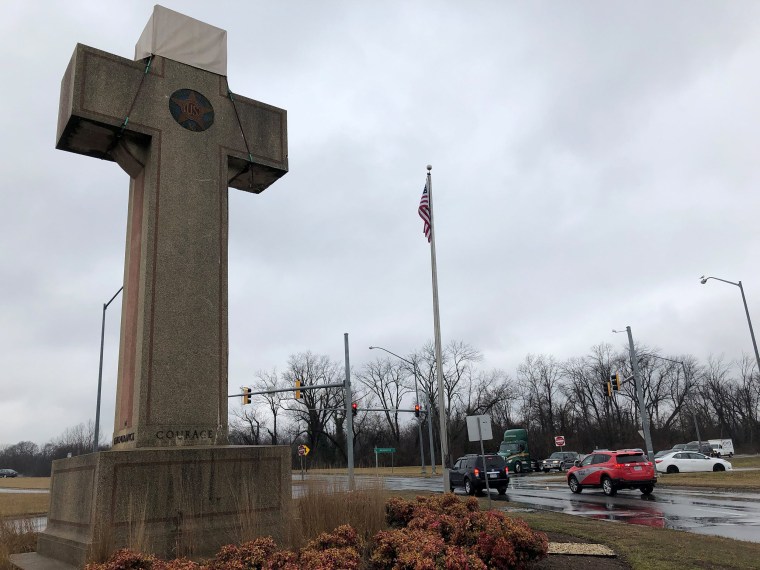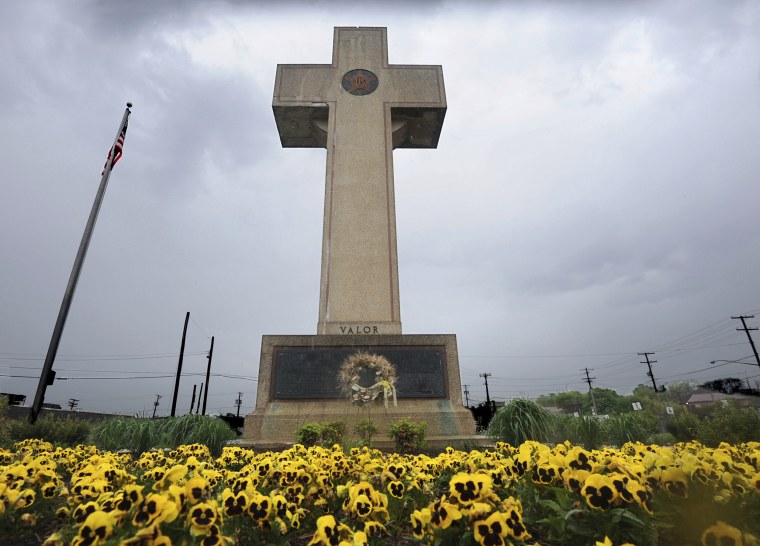WASHINGTON — For more than 90 years, a huge concrete cross has dominated part of Bladensburg, Maryland, a Washington suburb. On Wednesday, the Supreme Court will be asked to decide whether it should stay, raising a question that has vexed the justices for decades: What is the proper place for religion in American public life?
To its defenders, which include the state and the American Legion, the 40-foot-tall Peace Cross is a secular monument, a memorial to area war dead. To its detractors, it's an unconstitutional government endorsement of religion invoking Christianity's most potent symbol.
Completed in 1925, it was built to commemorate 49 servicemen who died in World War I. Their names are on a bronze plaque at the base. Private funds paid for the cross, but a state commission took it over in 1961 as well as the land it sits on, which is now in a busy traffic interchange.
In 2012, the American Humanist Association filed a lawsuit, claiming that its presence on public land violates the Constitution, amounting to a government establishment of religion. The 4th Circuit Court of Appeals in Virginia agreed, saying it could not ignore that "for thousands of years the Latin cross has represented Christianity."

Applying a test the Supreme Court has employed in the past to evaluate religious displays, the appeals court said a reasonable observer would conclude that the government "either places Christianity above other faiths, views being American and Christian as one in the same, or both."
Monica Miller, the Humanist association's senior counsel, says the cross was always intended to be a religious symbol, and its original planners wanted it to look like the cross of Calvary, described in the Bible as the place where Christ was crucified.
"The Latin cross is not embraced by non-Christians or used by them as a symbol of death or sacrifice," she says. When the government prominently displays the cross as a war memorial, "it does more than just align the state with Christianity. It also callously discriminates against patriotic soldiers who are not Christian."
The state parks commission defends the cross as a memorial designed to mirror the cross-shaped markers on the graves of American servicemen overseas. In the aftermath of World War I, the group says, crosses became the cultural symbol of the fallen, as depicted in one of the most famous poems of the war: "In Flanders fields the poppies blow/ Between the crosses, row on row."
Local governments may display symbols associated with a particular religion to honor historical events or acknowledge the role of religious faith in society, said Neal Katyal, a Washington lawyer representing the parks commission, and they don't threaten the values of religious neutrality. But requiring them to be torn down would promote a hostility to religion that the Constitution prohibits.
The American Legion also urges the court to abandon a test it has used for decades to determine whether government displays or expressions involving religious symbols would be seen by a reasonable person as a government endorsement of a particular religious faith.
"The test should be coercion," Michael Carvin, a D.C. lawyer representing the patriotic group, said. "Has there been some tangible threat to liberty because of what the government is doing, such as outright proselytizing? That should be the question."
A government's use of religion in a passive display does not compel people to support or participate in any religion, he says, and a memorial honoring war dead "is precisely where one would expect to encounter religious imagery in a government display."
The Trump administration agrees. Its friend of court brief says the Constitution's ban on an establishment of religion does not prohibit the acknowledgement of religion in public life. "Passive displays generally fall on the permissible side of that line, because they typically do not compel religious belief."
Past Supreme Court decisions on this question are widely considered to be a muddle of contradictions. The court has upheld opening legislative sessions with a prayer and has ruled against challenges to "In God We Trust" on currency or the phrase "Under God" in the Pledge of Allegiance. But it also invalidated displays of The Ten Commandments in local courthouses.
A decision is expected by late June.

